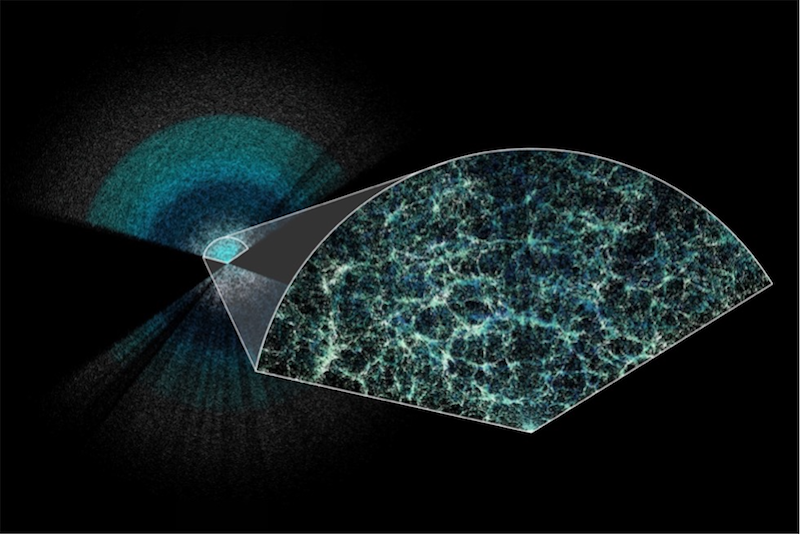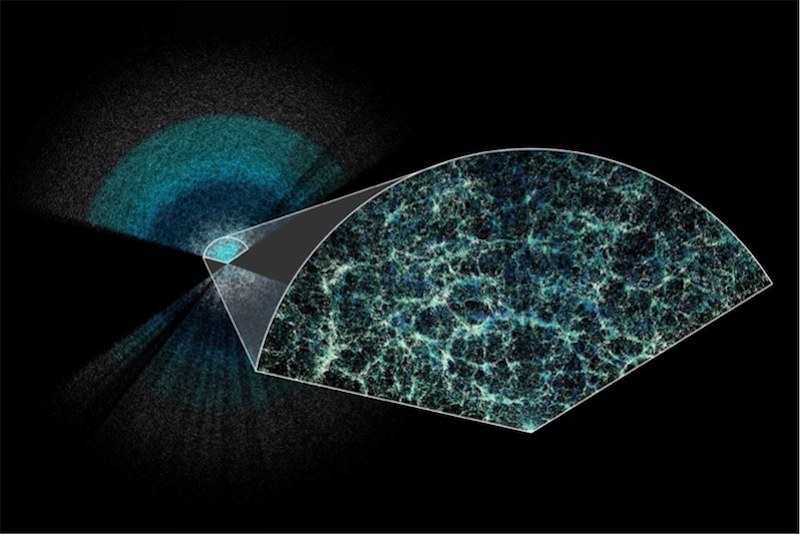High-Precision Map of the Universe Defies Conventional Cosmology
Analysis of a new high-precision map of millions of galaxies hints at a conflict with the standard model of cosmology known as ΛCDM. Last week, at the APS April Meeting in Sacramento, California, the Dark Energy Spectroscopic Instrument (DESI) Collaboration reported that their results favor a model in which dark energy—the force accelerating the expansion of the Universe—has properties that change with time [1]. Researchers have previously proposed versions of dark energy that conflict with ΛCDM’s assumption of fixed properties, but the new results are the best indication so far that those ideas may be on the right track. The reported discrepancy with ΛCDM lacks the statistical significance to claim a discovery, so the DESI Collaboration remains cautious about its importance until they have more data. But other experts are expecting theorists to immediately begin proposing revisions of ΛCDM.
“I think it’s pretty exciting that they see evidence for something beyond standard ΛCDM,” says cosmologist Rocky Kolb of the University of Chicago. “We have a standard model that we’re very proud of, and everyone wants to break it to see what’s behind it, and perhaps this is the first indication of it unraveling.”
DESI was designed to measure the properties of dark energy by mapping the cosmos with unprecedented precision (see Feature: Entering a New Era of Dark Energy Cosmology and Research News: Dark Energy Spectroscopy Instrument Releases First Data). The instrument is installed on a telescope on Kitt Peak, Arizona, and can collect simultaneous images from 5000 robotically positioned optical fibers, which will allow tens of millions of astronomical targets to be observed over five years. The first year’s worth of data, which were the basis for the new results, surpassed the quantity and precision of 10 years’ worth of data from its predecessors, the BOSS and eBOSS surveys, says one of the cospokepersons for the DESI Collaboration, Kyle Dawson of the University of Utah.
DESI measures the past 11 billion years of the Universe’s expansion thanks to a size reference, or “standard ruler,” imprinted in the Universe as a characteristic scale in the clustering of galaxies. The standard ruler was fixed in the early Universe, when sound waves produced regions with higher-than-average matter density that served as seeds for the formation of galaxies, leading to a preferred separation between pairs of galaxies. By measuring galaxy separations at various times throughout cosmic history, researchers can determine how the expansion of the Universe stretched the apparent size of the standard ruler. This preferred galaxy separation for distant galaxies is “a very, very faint signal,” Dawson says. “And that’s why we need so many galaxies to be able to tease it out.”
DESI mapped galaxies and quasars with unprecedented detail, creating the largest three-dimensional map of the Universe ever made. This effort marks the first measurement of the expansion history for the period of 8–11 billion years ago with a precision of better than 1%, providing a powerful way to study dark energy. With just its first year of data, DESI has surpassed all previous three-dimensional spectroscopic maps combined and has confirmed the basics of the ΛCDM model.
Comparing the evolution of the apparent ruler size with predictions of the ΛCDM model, the DESI team finds agreement. Specifically, the ratio of the density to the pressure of dark energy, called w, comes out to the predicted value of −1. But when the researchers modify the theory to allow w to vary over cosmic history, the DESI data favor this modification, although the error bars still overlap with the constant w theory. When performing a combined analysis of their data with previous measurements of the cosmic microwave background (CMB)—data that are generally consistent with the DESI data—the researchers find that the error bars no longer overlap. The analysis favors a time-dependent w at a statistical significance of 2.6 𝜎, which is close to the 3 𝜎 needed to claim “evidence” for such a result. This significance stays the same or grows to up to 3.9 𝜎 when the team combines these data with any of three previous supernova-based cosmology data sets.
The collaboration also reported several other cosmological parameters, including the Hubble constant H0, the current expansion rate of the Universe. One of the biggest cosmological mysteries is the disagreement between H0 values derived from measurements that probe the “early” Universe—such as those based on observations of the CMB—and those derived from measurements that probe the “late” Universe—such as those based on gauging the distances to supernovae used as “standard candles.” The value obtained by the DESI Collaboration is between 67 and 68.5 kilometers per second per megaparsec (km/s/Mpc), depending on which assumptions they use, which agrees with results derived from CMB measurements assuming the ΛCDM model. But supernova measurements give values in the range 73–76 km/s/Mpc, so the DESI results confirm this discrepancy.
Kolb says that with the ΛCDM model, cosmologists have been trying to understand the value of the cosmological constant (the unchanging dark energy)—where it comes from and how it relates to other physical constants. “And we haven’t been successful understanding that,” he says. But if the DESI result holds up, “maybe we’re trading a constant that we don’t understand for some dynamics that we don’t understand.… And as a physicist, dynamics is something that we grow up trying to explain” he says. “I can’t wait to think about it.”
“This is the most holistic and comprehensive challenge to ΛCDM. We’re able to really test what’s been assumed for the last 20 years,” Dawson says. He says the collaboration finished the data collection for the 3-year data set on March 31 and will be analyzing those data as rapidly as possible. He hopes that the increased precision will bring researchers closer to understanding the discrepancies with the ΛCDM model. “It’s really motivating us,” he says.
–David Ehrenstein
David Ehrenstein is a Senior Editor for Physics Magazine.
References
- APS April Meeting 2024, Session F01: First Year Results from the Dark Energy Spectroscopic Instrument (DESI).





